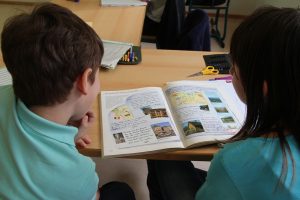
Blog Series: Why We should STOP teaching reading in schools
Part 8: The Complexity of Mapping/Integrating ACROSS Language Levels and Units
This blog series explores the development of Written Language: reading, spelling, and writing as a natural extension from oral language to visual language.
This blog series describes what reading IS – the integration of visual language (letters) into already-existing oral language processing systems (sounds, words, and vocabulary).
As we get into more complex words, we must map together more complex integrations.
To revisit our previous example, consider the letters “au”. These letters can represent a sound, such as short a /ah/ in “laugh”, or short vowel o “aw” in pause.
However, certain sequences of this vowel digraph plus a consonant must activate MEANING. If you see the word root “aur” or “aud”, you must start to convert these letters to mean “relating to the ear/hearing”. Notice here that we are relating “FUZZY” meaning – obscure, general meaning, NOT specific definitions. The Latin roots for ear and hearing are evident here, and the many derivatives from these roots that exist in English need to become connected, associated, and related in the brain: auditory, aural, audiologic, auriscope etc.
Notice just how complex it is to integrate between all these language units – sounds, sound strings (awd vs. or), letters, specific letter strings or sequences (aud, aur), partial words (word roots), spoken syllables (odd, orr), written syllables (aud, aur), partial meaning (ear, hearing), whole words, whole word meaning, and categorization (grouping of all aur/aud words relating to ear, hearing).
PROCESSING
Examples of information to be processed and integrated:
- The letter sequences “aur” and “aud” must be recognized and associated with a loose “kernel” of meaning relating to some aspect of “ear, hearing”; (visual, letter sequences)
- These letter sequences must be MAPPED/INTEGRATED/ASSOCIATED with both the “aw” and “oh” vowel sounds (both of which are ALREADY associated with the letter “o”, despite the fact that we don’t SEE the letter “o” with the /oh/ sound in “aur”).
- These sounds must be activated alongside the letter sequences to activate the “kernel” of vocabulary (word root word meaning).
- These letters and sounds must be associated across a grouping of words, a category of words relating to some aspect of “ear, hearing”; (semantic association)
- These processes must all occur quickly and accurately – near simultaneously – for mapping, long-term permanent storage, reading accuracy and fluency, comprehension, spelling accuracy, writing fluency, speaking, and association/generalization
There is a lot of complexity, specificity, flexibility, and association that the brain must “wire” together here!!
Note that reading will always have a RECOGNITION component and will be significantly easier. Conversely, spelling requires RETRIEVAL. Any attempt to spell “auriscope” that focuses on SOUNDS, phonics approaches, or visual memory (oriscope, ouriscope) etc. are doomed to fail.
Further, while many students CAN “memorize” a word like “auriscope” for a test, using visual memory means this NEW word replaces an OLD word in our 300 – 500 word capacity; and after the test, “auriscope” too will be replaced and dump, and the spelling lost.
The visual memory system does not provide the LONG-TERM PERMANENT STORAGE that occurs when we connect VISUAL language (letters) to the already-intact Oral language (the way a word sounds and what it means) vocabulary.
As alluded earlier, the student will not associate and generalize the spelling from auriscope to the word “aural” without the underlying structural language processing. They also will not relate and associate words like “aural” and “auditory” in their vocabulary, leading to less-robust reading comprehension and language expression.
The focus of instruction must SHIFT toward Language Processing and Integration – what does the word MEAN, what is the STRUCTURE of the word across multiple language levels such as sounds, syllables, and suffixes, how is it used in context, how does it function in phrases and sentences, what other words is it associated with by meaning and structure, and what does it look like – how do we read it and spell it OUTSIDE of context, and then how do we recognize it when reading in a sentence (fluency, comprehension) and how do we USE it when writing (retrieval, language formulation and organization, speech, spelling).
~
Watch for part 9 and beyond of this blog series as we consider red flags
Read Intro: Why We should STOP teaching Reading Schools
Read Part 1: What are the components of Oral language?
Read Part 2: What is Visual or Written Language, and how is it INTEGRATED?
Read Part 3: Spoken word Structure, Written Word Structure, and Word Meaning: MAPPING Language Units
Read Part 4: More Integration through Mapping – Mapping Words
Read Part 5: Mapping, Word Mapping, “Sight Word” storage, and Irregular Words
Read Part 6: Stop teaching “Reading” and recognize instead that students are learning LANGUAGE
Read Part 7: Integration of Language Levels and Language Units: Visual to Oral language
Got questions, concerns, yeah buts? Visit www.speak2read.ca to engage in some delightful conversation on how you can improve your reading instruction or your child’s learning.

